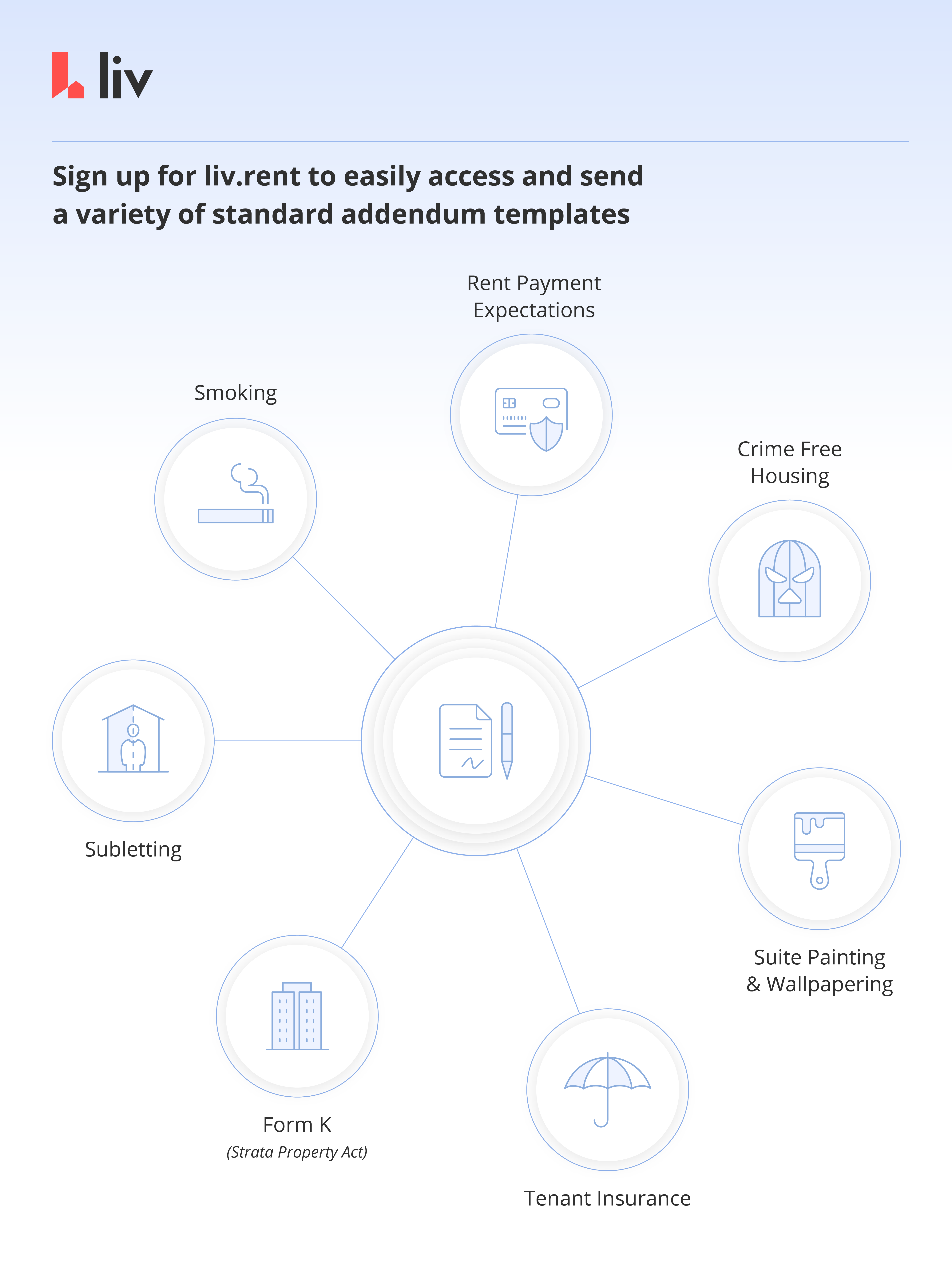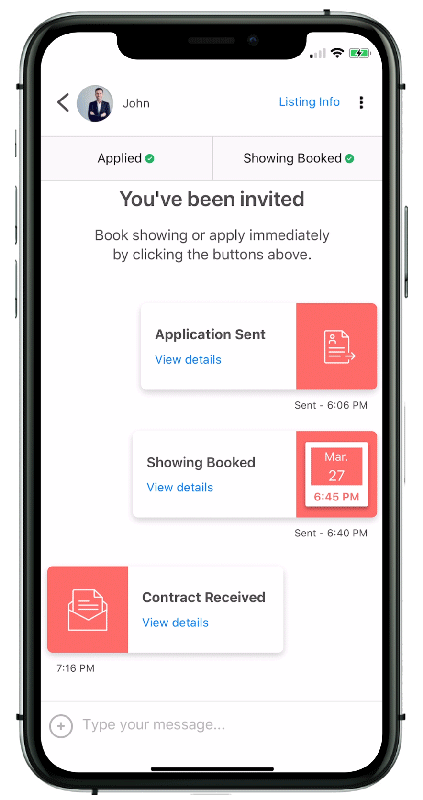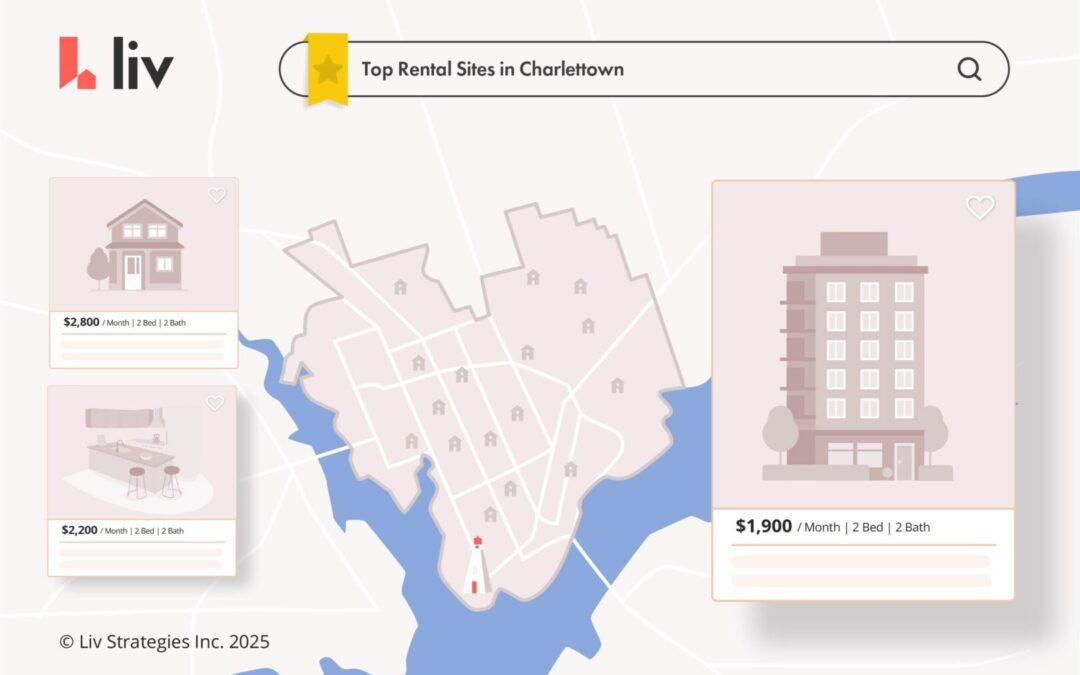Lease addendums are an invaluable tool for landlords looking to solidify the terms of their rental agreement and head off potential problems during a tenancy. In Part 1, we gave an overview of what exactly lease addendums are and how you can incorporate them into your rental process. Now, let’s dive a bit deeper. In this article, we’ll give you a closer look at some of the different types of addenda landlords and property managers use to bulletproof their lease agreements, as well as providing some tips on how you can create your own within the liv.rent platform.
Table of Contents
Top 7 most common lease addendums in Canada
3. Form K (Strata Property Act) Addendum
4. Rent Payment Expectations Addendum
5. Agreement For Crime Free Housing Addendum
Top 7 most common lease addendums in Canada
Landlords have a variety of lease addendums at their disposal to help add detail to their original lease agreements. Knowing which ones to use for a given rental unit can require experience, but even novice landlords would do well to include addendums for anything they’re concerned about.
Put simply, addenda are a way for landlords to further protect themselves against the many things that can go wrong during a tenancy. If you aren’t armed with the proper legal documentation, any issues with renters can become a murky subject and lead to complicated disputes later on. Thankfully, there’s an easier way to bulletproof your lease and ensure that any potential problems are addressed long before they become an issue. With liv.rent, landlords and property managers can create and sign digital contracts including some of the most common lease addendums, as well as creating their own custom addenda right within the platform. So, what options are available to landlords? Let’s take a look.
Looking for an easier way to create and sign digital contracts and standard lease addendums? Sign up to liv.rent and streamline your rental process today.
1. Smoking Addendum
One of the most common types of addendum landlords and tenants are likely to see is a Smoking Addendum. In both B.C. and Ontario, there are laws in place to ban smoking from indoor public spaces but not within individual residences — rental properties included. For landlords to codify that their unit is designated as non-smoking, they must include the required Smoking Addendum.
This lease addendum will also lay out exactly what is and isn’t allowed within its terms. In this case, it’s standard to make clear what types of smoke are not permitted (vaping/e-cigarettes, tobacco, cannabis), exceptions to these rules, and consequences for refusing to follow them. Smoking Addendums may also prohibit the growing of marijuana/cannabis within the unit as well.
2. Subletting Addendum
Another common issue landlords face is when a tenant needs to sublet their property for whatever reason. Subletting is allowed within both B.C.’s Residential Tenancy Agreement and Ontario’s Standard Lease, but it’s important for landlords to further outline exactly what is required of tenants and how the subletting process will go. In standard leases, the only provision is that a landlord may either accept the sublet or deny it, but the grounds for doing so and further guidelines are not specified.
A Subletting Addendum clarifies these issues, and generally gives landlords permission to run credit/background checks on subletters, in addition to stating the grounds under which they may reject a proposed subletter. A Subletting Addendum will usually also outline what happens if a tenant sublets without the landlord’s permission — generally ending the tenancy for both the original tenant and the subletter unless a new lease is able to be negotiated. This is hugely important for landlords as it clears up any grey area that exists within a standard lease and lets tenants know the precise consequences for subletting without permission.
3. Form K (Strata Property Act) Addendum
This addendum is specific to B.C., but similar addendums concerning condominiums may exist in Ontario as well. The Form K Addendum specifies that tenants in a Strata Corporation must comply with any additional rules and bylaws which are usually laid out in an additional document at the time of signing the lease.
The Form K addendum also lays out what happens when a tenant goes against these rules, generally — fees, denial of access to shared facilities, or payment for any costs incurred from their actions. This is all intended to protect landlords from these penalties, as without an addendum they would generally be on the hook for any liabilities their tenant causes.
4. Rent Payment Expectations Addendum
A standard lease outlines the basics of rent payment, including the amount to be paid, the frequency, which day of the month it’s due, and what is included. It also makes clear that failure to pay rent will result in a Notice to End Tenancy, which allows the landlord to evict the tenant unless they dispute the notice. This is usually clear enough for most situations, but some landlords may want to provide further explanation to ensure tenants understand exactly what happens when they miss rent or pay late multiple times. In this case, they may want to include a Rent Payment Expectations Addendum.
A Rent Payment Expectations Addendum provides further explanation for the situations where rent is not received or is received late. Generally, it will include conditions for fees that arise as a result of non-sufficient funds, as well as letting tenants know that the money for rent must remain in their account until it is withdrawn, even in the event of a public holiday where funds may take longer to come out of their account. It will also clarify any confusion regarding the 10 Day Notice To End Tenancy, including the timeline for dispute.
5. Agreement For Crime Free Housing Addendum
It may seem obvious to state that criminal activity isn’t permitted in rental units, but most standard leases have nothing to say on the subject. While the Criminal Code of Canada is obviously still in play, landlords can also add conditions allowing them to evict tenants based on evidence of criminal activity rather than waiting for a conviction. In this case, they may want to include an Agreement For Crime Free Housing Addendum so that they don’t become entangled in criminal issues as a result of their tenant’s activity.
This addendum makes clear that any criminal activity on the part of the tenant or any guests is grounds for a Notice To End Tenancy, based on evidence rather than a criminal conviction. It also generally states that the addendum itself will supersede the Residential Tenancy Agreement in the case of conflicting terms. While no landlord wants to even think about criminal activity occurring within their rental property, it’s wise to plan for the worst-case scenario and an Agreement For Crime Free Housing Addendum does just that.
6. Suite Painting And Wallpapering Addendum
Tenants often think they can paint or wallpaper their unit at will, which is usually not the case. Making sure a suite has a reasonably fresh coat of paint is the landlord’s responsibility before move-in, and any painting following that needs direct approval from the landlord unless it is professionally done in the exact same colour as was originally there.
A Suite Painting and Wallpapering Addendum puts this in writing, stating that the tenant must have written permission before altering the paint colour of the unit, and must return it to its original state or a state suitable to the landlord before the tenancy ends. This addendum also typically makes clear that the tenant is responsible for any costs for painting and wallpapering the unit, should approval be given. Including these conditions is important for landlords, as most standard leases in Canada contain nothing about painting a unit. If a landlord doesn’t want to be surprised by bright yellow walls the next time they enter the suite, it’s a good idea to include a Suite Painting and Wallpapering Addendum.
7. Tenant Insurance Addendum
Tenant’s insurance is always a welcome sight for landlords, as it helps them ensure that they’ll receive compensation in the event of a tenant causing serious damage to their unit. It also protects tenants themselves against any damage to their personal belongings and any injuries to them or others that may occur within the rental property. While it is usually considered a bonus, some landlords may choose to make it a mandatory condition for tenancy, or strongly recommend it and lay out the potential consequences of not having a policy.
A Tenant Insurance Addendum does just that, making it clear exactly what the tenant could potentially be liable for and stressing the financial burden that can come with not having tenant’s insurance. It will also usually have the tenant agree that any injuries or damage that occur are not the fault of the landlord, except if they’re caused by the landlord’s own negligence. Encouraging renters to insure themselves is never a bad idea, and having this laid out in plain language serves to protect landlords in the event of a tenant trying to sue them for damages later on.

Other common addendums
In addition to the most frequently used addendums outlined above (which, as we’ve mentioned, are all available as templates right here on liv.rent!), there are a number of other addendums landlords frequently use to add detail to their original lease agreements. It’s worth noting that landlords can include almost anything in an addendum, so long as it’s reasonable and within residential tenancy laws for their province, so this list is by no means exhaustive. Let’s look at some of the other type of addendums you may see or use:
Lost Or Damaged Keys Addendum
If a landlord collects a key deposit from their tenants at the time of signing the lease, they’ll want to include this in a separate addendum. The addendum states the amount collected, the conditions for its return, and any additional rules surrounding keys, such as having them copied, lending them to unauthorized individuals, etc.
Additional Occupants Addendum
To ensure that only the tenants on the lease will be staying in the unit, a landlord may want to include an addendum regarding additional occupants. This simply states that only the specified renters are allowed to occupy the unit, and that having additional occupants is grounds for termination of the lease agreement.
Appliance Care Addendum
Maintaining appliances within the unit is generally a landlord’s responsibility, except when repairs are needed due to the tenant’s misuse of the appliance. An Appliance Care Addendum puts this in writing, stating that a tenant must arrange and pay for repair when it is caused by improper use on their part.
Legally Required Disclosure Addendum
Things like lead-based paint, asbestos, or mould must be disclosed to tenants at the time of signing. Usually, this can be included directly in the original lease, but an addendum will suffice should you leave it out.
Option To Purchase Addendum
Landlords can include an addendum that gives renters the option to purchase the rental property at the end of their lease. This is usually a detailed document that outlines how the transfer of property will occur, the price, and other stipulations.
Pet Addendum
Most standard leases include the option to include a pet deposit, and landlords can insist on a pet-free unit altogether, but they can also include an addendum that sets out specific conditions regarding the type and quantity of pets allowed, and other rules regarding their behaviour within the rental property.
How to create lease addendums on liv.rent
Now that we’ve gone over the many types of lease addendums available to landlords, let’s discuss how you can easily apply these to your own rental process. In Part 1 of our series on lease addendums, we gave a basic overview of how to create your own addenda, and where you could find templates online. Thankfully, you won’t have to look far.
Using liv.rent, landlords can easily create their own addendums right within the platform, upload their own existing addendums, as well as access and include a variety of standard addendum templates we’ve created for you. These can be edited to your specific needs and included alongside your lease agreement when it’s time for a tenant to digitally sign contracts. This is a fantastic way for landlords to add detail to their original lease agreements and further protect themselves against the many issues that can arise during a tenancy. Normally, creating your own lease addendums requires time and a legal expert’s advice to ensure everything is in the right place, but we’re here to help streamline the process by giving landlords access to a variety of common addenda right within the liv.rent platform.
Watch our How-To Video for more information on how to use liv.rent to create and sign digital contracts and lease addendums.

Rethink The Way You Rent
Not on liv.rent yet? Experience the ease of digital applications & contracts, verified tenants & landlords, virtual tours and more – all on one platform. Sign up for free or download the app.
Subscribe to receive the latest tenant & landlord tips and get notified about changes in the Canadian rental market.
>> Stay up-to-date on the average rent in Vancouver, Toronto and Montreal: Rent Reports.




0 Comments